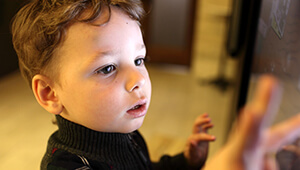Explore a Discovery Museum


Kids are born with a passion for opening, pushing, pulling, and touching. For the youngest preschoolers, a children’s museum offers the tactile experience of a lifetime. Three- and 4-year-olds, with their burgeoning imaginations, will find plenty of opportunities to pretend. Their increasing willingness to try different adventures will ensure that you’ll cover lots of ground on this outing. Jenny Burch, director of visitor relations at the Children’s Museum of Indianapolis and Jhoanna Wade, a journalist and mother of a young museum fanatic, offer these tips for making the most of a discovery museum visit.
Before you go
Check out the Web site. As with any expedition, a little planning will help you unearth the best exhibits for your child’s age and interests. Most children’s museums have Web sites where you can look for age-specific exhibits, perhaps finding ones on the very subject your child currently finds fascinating or familiar, such as dinosaurs or trains. You can also check on admission prices, hours, special exhibits, and amenities. As a final precaution, call the museum the day before your visit to make sure any anticipated exhibits aren’t out of commission.
Dress your child appropriately. Be sure to outfit your kid in clothes that can weather some real discoveries – something you or he won’t mind getting wet or dirty. When it comes to shoes, think comfort, since your child will be spending plenty of time on his feet. And go with layers – you don’t want to have to leave the museum prematurely because your child is too hot or too cold.
When to go
Children’s museums bustle during annual school breaks in the spring, winter, and summer. If you can visit during regular school hours, the museum may be less crowded. Even then, try for a late afternoon visit, since during the school year, classes often tour between 10 a.m. and 1 p.m. Sunday mornings are a quieter time to visit, too. When planning a visit during busier hours, see if you can purchase tickets for temporary exhibits or scheduled events ahead of time. Museums plan for these busy times and may add additional activities, so check on this as well.
Once you arrive
Hit outdoor exhibits or parks first. If the museum has an outdoor play area – or even if it’s close to a park – spend a little time there first to let your child run around and get the rambunctiousness out of his system. This will help ensure that once you’re inside, your child is ready to calmly focus on the exhibits instead of racing around expending pent-up energy. (If there’s not a park nearby, have your child sing loudly in the car on the way to the museum.)
Review the floor plan. Locate rest rooms, snack areas, and your must-see exhibits. You may, in fact, want to make a prized exhibit the last stop on your tour: If your child knows that the locomotive or the colored dinosaur is the big finale, it may be easier to leave the rest of the fun behind when it’s time to go home.
Look for water. Most kids love anything to do with water. So if your child hasn’t led the way, you might want to point out those exhibits with splash appeal.
Look for age-appropriate activities. Not only does this help ensure that your child is engaging in an activity he can truly learn and enjoy, but he’ll have an easier time interacting with other visitors; an older, grade-school kid could intimidate your young child. If the Web site doesn’t specify age ranges for each gallery, ask the staff which ones best suit your child’s age.
Turn the experience into an informational treasure hunt. Come up with ten questions based on the exhibits (you can do this beforehand by checking the Web site, or while your child is engrossed at a favorite exhibit). Some sample questions include: What color is the male loon? What’s the name of the largest dinosaur that ever lived? Be sure that pre-readers can figure out the answers without having to read displays. Once your child answers all the questions correctly, reward him with an ice cream cone or other treat. Not only does a treasure hunt keep an easily overwhelmed child focused on the exhibits at hand, but it helps him to retain some information about his discoveries.
Count on deviating from the plan. Even if you’ve plotted the perfect path through the museum, you should still follow your child’s lead. If he wants to spend 45 minutes at the magnet exhibit, let him, even if it means missing something else. You may want to gently remind him of other things in the museum, but don’t force him to move on if he’s really enjoying himself. You can always return another day to visit not-yet-seen exhibits.
Talk with the educational staff. Generally, museums station volunteers or employees at the exhibits. They are ready, willing, and eager to share information and to answer questions.
Ask about services. The staff members know the needs of kids and parents. If your child gets doused at the water table, the staff may have air dryers or a change of clothes available. Camcorder battery low? The staff just might be able to charge it for you. It’s also possible there’s a nurse on duty if you or your child needs specialized care.
Hands-on protocol. If a child or group of children is monopolizing a display, politely ask if your child may have a turn. Or ask the museum personnel for help.
Time your exit. There’s a world of information to explore, so if your child often gets tired and cranky around 2, plan the big finale for 1, so you can both leave happy instead of grumpy. Remind your child that you can always come back or visit another museum. If your child is loath to leave, offer to buy him a souvenir on the way out: It doesn’t have to be expensive – even stickers will do – but it caps off the visit and serves as a fun reminder of the experience.
What to expect
Exhibits vary widely from museum to museum, but here’s a sample of what your child might be doing: crawling through habitats of underground animals, examining a watershed table, preparing meals in a play diner, digging in sand, or dressing in costumes of animals or characters. And, most certainly, your child will be pushing, pulling, and pressing every imaginable button, dial, pulley, and lever. Be prepared for lots of physical, as well as mental, activity. Think about steering your child to the role-playing exhibits, especially if he’s been clamoring to do more “grown-up” things. From working a real ATM (at the Children’s Museum of South Carolina in Myrtle Beach) to “riding” an actual police motorcycle (at the Tucson Children’s Museum in Arizona), a children’s museum is filled with setting where kids can dispense with the rules of the real world.
What to bring
- A camera to snap your child making new discoveries.
- Museums don’t allow food or drink in the galleries, but generally provide a snack area where you can break out the refreshments.
- A stroller. While your child may spend a lot of time on his feet, he may get tired before he’s truly ready to leave. You can then plop your little explorer in the stroller and tour around until he gets a second wind.
- A few toys and books from home. Your child may want to take a break and retreat into something familiar – a favorite book or stuffed animal can offer a much-needed, calm break from all the newness and excitement.
Bring the experience home
Many of the experiences in a discovery museum focus on the senses – the way things feel, sound, look. To create a fun sensory experience right at home, try this: Blindfold your child (or have him close his eyes) and walk him around the house, making noises he’s used to hearing, like shutting the refrigerator door, opening a window, turning on the faucet. Have him guess what the sound is. If he guesses right away, try for more subtle sounds: the flick of a lamp switch, the raising of a shade. Then switch roles.
A fun fact
Did you know that dinosaurs could be named after people? One discoverer named the herrerasaurus after his buddy, Señor Herrera. For more dinosaur data, check out this Web site about dinosaurs (www.childrensmuseum.org).
This article has been adapted from original content written and provided by BabyCenter.com. © BabyCenter, L.L.C. 2005. All rights reserved.


